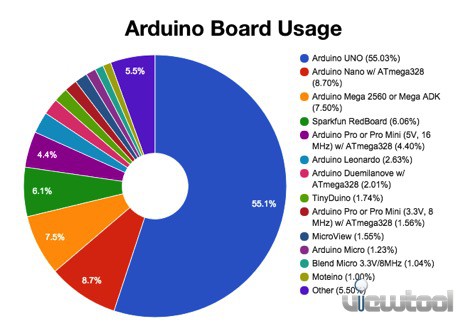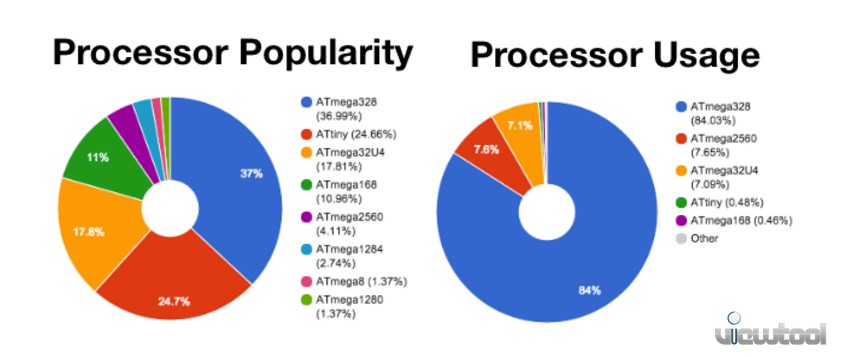his guest post is brought to you by Vasilis Georgitzikis, founder of codebender, an online Arduino IDE that allows you to program your Arduino on the cloud. These insights are based on anonymous usage data gathered by codebender.
Arduino - The board, the myth, the legend!Ever wondered which Arduino boards are the most popular, which are the most used processors, which are the most common Libraries (and Examples), and how are they being used? At codebender we have a unique insight on this, since we have more than 40,000 people using codebender to write Arduino code, and more than 100,000 sketches. This gives us the ability to gather anonymous data on board usage, popular boards, etc. And since we host more than 500 built-in libraries, we also get a great view on the preferred Libraries as well. Let’s dive in! The most popular kid on the blockFirst, we’re going to look into the popularity of each Arduino board. The easiest way to count this is to take a look at which board people use most often. We counted how many times people programmed/”flashed” a particular board (say, an Arduino UNO), vs. the total number of times someone programmed a board on codebender during September (which was 123,967 times). As with any good research, we’re gonna start with a couple of notes: - When you look at this, keep in mind that codebender only supports AVR-based boards right now, so boards like the Due, Zero and Galileo/Edison are not counted here.
- This research is based on usage on codebender, not across all Arduino users. But there’s no reason to think that this would be any different, so it’s fair to say that what we see here applies to the Arduino community at large.
- There is a caveat to the above - codebender has some partnerships with hardware manufacturers who suggest codebender for their boards, so naturally we will have slightly inflated numbers for these.
So, without further ado, here are the results (showing only boards with more than 1% usage):

Wow! Everyone knows Arduino UNO is the most popular board, but did you know that in more than half of the instances an Arduino is programmed, it’s an Arduino UNO? I also personally didn’t expect the Arduino Nano to be so popular, let alone #2! I’m more of a Pro Mini/Pro Micro guy myself, since I’m a bit of a SparkFun nerd. A reason for this spike could be the recent surge of ridiculously affordable Arduino Nano-compatible boards from China, using the very inexpensive CH340G chip for the USB-to-Serial instead of the more common FTDI chip. Another item of note is the number of Duemilanove boards still in use (remember, they are 6 years old), which are still almost as popular as the Leonardo. The Leonardo, by the way, is much lower than I expected. It goes to show that issues with the way the Leonardo’s programming was implemented - the less-than-stellar robustness when programming and all the inconsistencies it brings with existing code and Libraries - outweigh the extra features and lower price. Long live the UNO! (By the way, notice that 4 out of the 13 most popular boards are manufactured by SparkFun. Not bad, huh?) Official Boards OnlyOk, as we said above, some boards are bound to be a bit inflated because their manufacturer suggests codebender as the tool of choice for Arduino coding. Let’s look at the same numbers, this time using only the official Arduino boards. Here are the results (showing only boards with more than 1% usage):

Old but goldFor the last chart, we thought it would be interesting to see the most popular microprocessor chip in Arduino land. On the left chart, we measure the number of boards that use a certain chip. Out of the 80 boards that codebender supports built-in, how many boards use each chip? The right chart measures the number of times an Arduino is programmed, so we can see how many times people programed a board with a certain processor (i.e. ATmega328), compared to the total number of times people programmed a board.

And the winner is, of course, the ATmega328 by far. First, we see that a good third of the boards supported in codebender are using the ATmega328. ATtiny in second place seems weird at first, but given that there are around 20 different boards for the various ATtiny chips and configurations, it makes sense. And then, you have the ATmega32U4 devices. There are a lot of independent manufacturers making boards based on this chip, but as we saw on the previous chart (and as you can see on the Processor Usage chart above), they end up not being used too frequently. As you can see on the Processor Usage chart, more than 4 out of 5 times someone programs an Arduino, it’s using an ATmega328. Isn’t that simply amazing? Well, that’s all folks! I hope you enjoyed the post. I’m really looking forward to sharing more data - next we will shed some light on the Libraries that people use with Arduino. 加公众号【纬图物联】:

|